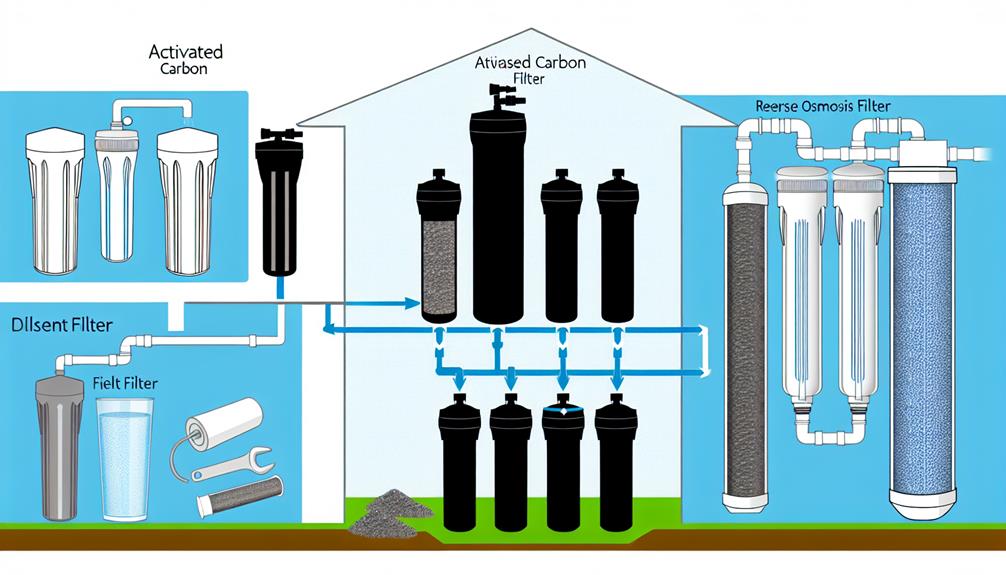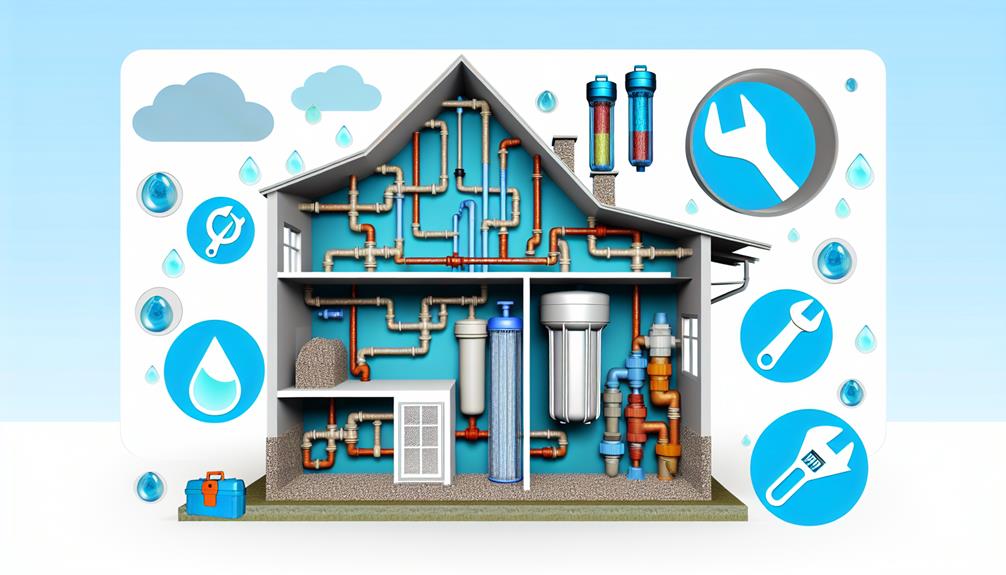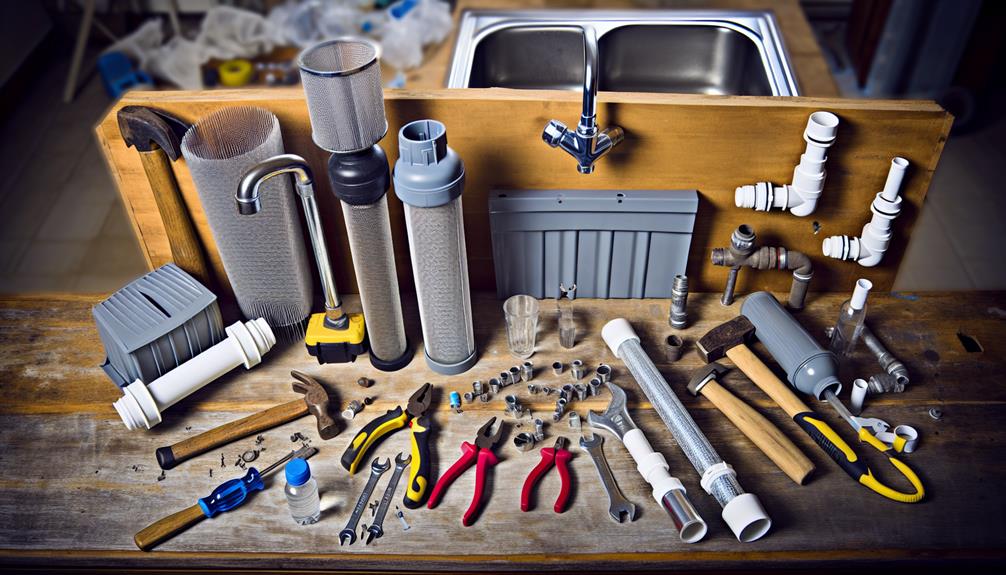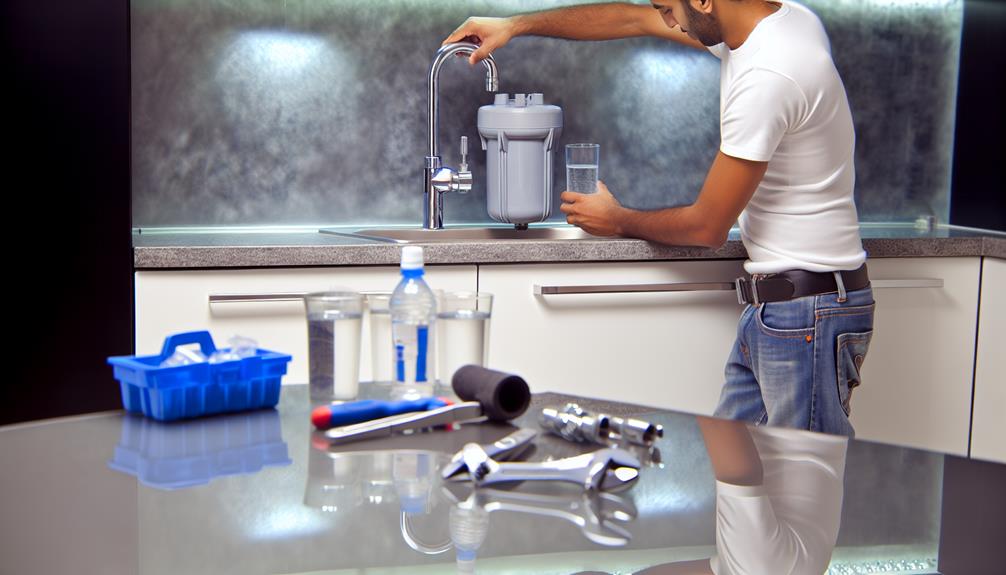As you select, secure, and set up your whole home water filter, you're not just investing in a piece of equipment; you're committing to the health and well-being of your family through cleaner, purer water.
With a myriad of options on the market, you'll want to ensure you've chosen the right system that meets your specific needs—whether that's removing minerals, sediments, or contaminants. You'll also need to prepare for the installation, which requires a clear understanding of your home's plumbing layout and the filter's specifications.
Once installed, you mustn't forget the ongoing care that your system demands to function efficiently. But what if you encounter unexpected hiccups along the way, or if the water quality doesn't meet your expectations after installation?
In the following sections, we'll explore how to navigate these waters, ensuring your investment remains sound and your water, impeccably clean.
Choosing the Right Filter

Selecting the appropriate water filter for your home hinges on understanding the specific contaminants present in your water supply and your household's water consumption needs. Prioritize contaminant testing to ascertain the concentration and variety of impurities, such as sediment, heavy metals, chlorine, and organic compounds. Laboratories or test kits can provide a comprehensive analysis, informing your decision on which filtration technology—activated carbon, reverse osmosis, ion exchange, or ultraviolet treatment—matches your requirements.
Factor in filter lifespan, which varies depending on the type and quality of the filter, as well as your water usage. A filter's longevity is a critical aspect, as it affects maintenance frequency and overall cost-effectiveness. High-capacity filters may offer extended service intervals, reducing the need for frequent replacements and ensuring a consistent supply of clean water.
Review technical specifications of potential water filters, including their flow rate, which should align with your home's demand to avoid disruptions in water pressure. Ensure that the chosen filter is certified by reputable organizations, such as NSF International or the Water Quality Association, to validate performance claims. This diligent approach guarantees the selection of a reliable, efficient water filtration system tailored to your home's specific needs.
Pre-Installation Preparation
Before embarking on the installation of your chosen whole home water filter, it's essential to gather all necessary tools and familiarize yourself with the system's components and installation requirements. Scrutinize the manufacturer's manual meticulously to comprehend the specifics of the model. Ensure you have an accurate water analysis report at hand; this will dictate the type of filtration required based on the contaminants present in your water supply.
Conducting a water analysis prior to installation can prevent future performance issues. This analysis provides critical information on the water's pH level, hardness, and the presence of heavy metals or organic compounds. Ascertaining these parameters will allow you to select the appropriate filter media and configuration.
Consulting with a licensed plumber can also provide invaluable insights, especially regarding local plumbing codes and potential challenges specific to your home's infrastructure. This professional consultation is particularly crucial if you're unfamiliar with plumbing systems or if the installation process seems daunting.
Lastly, prepare your installation site by ensuring ample space for both the filter unit and for maneuvering during the installation. Clear the area of obstructions and verify that you have shut off the main water supply to avoid any inadvertent water damage during the process.
Step-by-Step Installation Process
Ensure you have shut off the main water supply to your home before commencing the installation of your whole home water filter. Proper filter positioning and connection sealing are critical for effective operation and to prevent leaks. Follow these detailed steps to ensure a secure installation:
- Identify the Installation Location:
- Select an area close to the main water supply line for optimal filter positioning. Ensure it's easily accessible for future maintenance.
- Install Fittings and Shut-Off Valves:
- Attach the appropriate fittings to the inlet and outlet ports of the filter head. Use high-quality thread sealant or Teflon tape on threads to ensure connection sealing.
- Mount the Filter Unit:
- Secure the filter bracket to a wall or a stable surface. Make certain it's mounted in the correct orientation as per the manufacturer's specifications to maintain proper water flow direction.
- Connect the Water Supply Lines:
- Carefully align the pipes to the filter's inlet and outlet, ensuring no cross threading occurs. Tighten connections firmly, but don't over-torque, which could damage the fittings.
After installation, slowly turn the main water supply back on and check for any leaks at the connections. If all is secure, your whole home water filter is ready for operation.
Routine Maintenance Schedule
Having successfully installed your whole home water filter, it's crucial to establish a routine maintenance schedule to maintain its efficiency and longevity. Adhering to a structured plan ensures optimal water quality and extends the filter lifespan, safeguarding your investment.
Initiate your schedule by recording the installation date; this serves as a reference point for future maintenance activities. Replace sediment pre-filters every 2-3 months or as specified by the manufacturer, since accumulated debris can impede water flow and reduce filtration efficacy. Carbon filters, responsible for removing chlorine and organic compounds, typically require replacement every 6-12 months. However, this interval can vary based on your water usage and the initial water quality.
Monitor the system's pressure gauges, if equipped, to detect any abnormal fluctuations indicating potential clogs or the need for filter replacement. Additionally, every 3-5 years, it's recommended to service the main tank and replace the media inside, if your system includes media that targets specific contaminants.
Always consult your manufacturer's guidelines for precise maintenance instructions tailored to your specific filtration system. By diligently following a maintenance schedule, you can ensure continuous provision of clean, safe water throughout your home.
Troubleshooting Common Issues

Despite regular maintenance, you may encounter issues with your whole home water filter; understanding how to troubleshoot common problems is essential for quick and effective resolution. Here's a concise guide to addressing some of the issues you might face:
- Reduced Water Pressure: If you notice a significant drop in water pressure, it's possible that your filter is clogged. Check the manufacturer's specifications to determine the filter lifespan and replace it if necessary. Additionally, verify that no bypass valves are partially closed, which can restrict flow.
- Unusual Noises: Hearing strange sounds emanating from your filtration system can indicate trapped air or a malfunction within the unit. Perform a system backwash or consult the manual for air purge procedures.
- Leaks: Persistent moisture or water pooling around the system can be a sign of compromised connections or worn-out seals. Tighten fittings and replace seals or O-rings as needed to maintain an effective seal.
- Water Quality Decline: If the water starts to taste or smell off, or if sediment appears, the filter may be nearing the end of its lifespan or a specific media within the unit may need replenishment. Replace filters or media according to the suggested schedule to ensure optimal water quality.
Always refer to your system's manual for specific troubleshooting steps and contact a professional if the issue persists or is beyond your technical expertise.
Conclusion
In conclusion, you've taken a vital step in ensuring your household's water purity by selecting and installing a whole home water filter.
Remember to adhere to the routine maintenance schedule to keep the system operating optimally.
Should issues arise, refer to the troubleshooting guide to address common problems efficiently.
Vigilance in care and prompt attention to any irregularities will ensure your filter provides clean, safe water for years to come.

